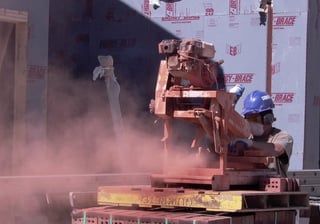
OSHA's final Crystalline & Silica Rule has been officially published in the federal register and will be effective on June 23, 2016. Compliance date range from June 23, 2017 for the Construction Industry with most of General Industry meeting compliance in June 2018.
Some of the key provisions of the new standard include:
- Reducing the permissible exposure limit (PEL) for respirable crystalline silica to 50 µg/m3, (0.05 mg/m3, equal to the lead standard) averaged over an 8-hour period (TWA) with an action level of 25 μg/m3 TWA.
- All employers covered by the standard (with TWA exposures above 50 μg/m3) are required to:
- Establish and implement a written exposure control plan.
- Train workers in hazards and control methods.
- Restrict housekeeping practices that expose workers to silica.
- Offer medical exams – including chest X-rays and lung function tests – upon initial employment with periodic exams at least every three years for workers who are potentially exposed over the PEL for 30 or more days per year.
- Keep records of workers’ silica exposure and medical exams.
- Repeat exposure monitoring every 3 months.
- Employers with exposure assessments indicating TWA exposure at or above 25 μg/m3 must:
- Train workers in hazards and methods to minimize exposure.
- Offer medical exams as described above.
- Repeat exposure monitoring every 6 months.
Construction Industry – Compliance Date is June 23, 2017, one year after the effective date.
- “Designate a competent person to implement the written exposure control plan.”
- OSHA provides specific control methods for common construction tasks that can be used to control silica exposure. Other methods can be used if the employer documents the effectiveness of the method by measuring worker exposures. Recommended control methods are listed in TABLE 1.
- OSHA states, “Employers who follow Table 1 correctly are not required to measure workers’ exposure to silica and are not subject to the PEL.”
- Employers who do not use control methods on Table 1 must:
- Measure workers exposure if it may be at or above an action level of 25 μg/m3 TWA
- Protect workers from silica exposures above the PEL of 50 μg/m3 TWA
- Use dust controls to protect workers from silica exposures above the PEL.
- Provide respirators to workers when exposure cannot be limited to the PEL
General Industry- June 23, 2018, two years after the effective date.
General Industry requirements are similar to the Construction Industry, but there is no list of recommended control methods.
- “Measure silica exposures if it may be at or above an action level of 25 μg/m3 TWA
- Protect workers from silica exposures above the PEL of 50 μg/m3 TWA
- Use dust controls to protect workers from silica exposures above the PEL.
- Provide respirators to workers when exposure cannot be limited to the PEL
- Limit workers’ access to areas above the PEL”
“General industry employers must comply by June 23, 2018, except for the following:
- Medical surveillance must be offered to employees who will be exposed at or above the action level for 30 or more days a year starting on June 23, 2020
- Medical surveillance must be offered to employees who will be exposed above the PEL for 30 or more days a year starting June 23, 2018”
“Hydraulic fracturing operations in the oil and gas industry must implement (all other requirements as above, except for) engineering controls to limit exposures to the PEL by June 23, 2021.”
If you have questions about this standard, or if you need assistance with your compliance, please feel free to contact Emilcott!
Written by Laurie deLaski, CIH.


